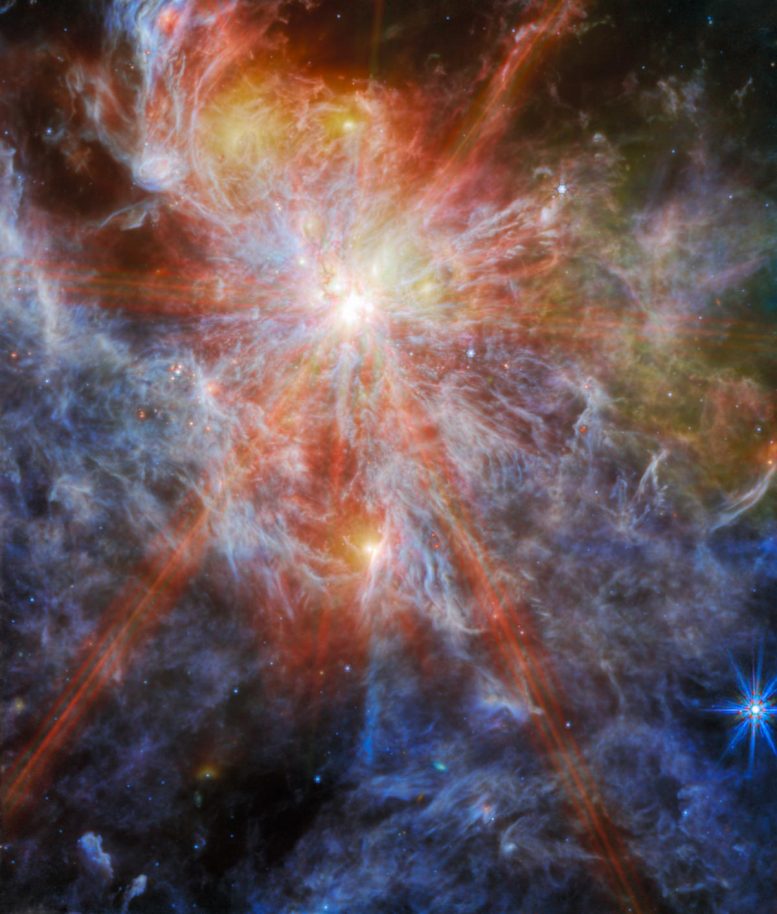
The James Webb Space Telescope has captured a stunning image of N79, a vibrant star-forming region in the Large Magellanic Cloud, highlighting its potential as a younger version of the Tarantula Nebula. This observation, revealing the area’s glowing gas and dust through mid-infrared light, offers valuable insights into the early Universe’s star formation processes and chemical compositions, differing markedly from those in our Milky Way. Credit: ESA/Webb, NASA & CSA, O. Nayak, M. Meixner
The James Webb Space Telescope reveals the inner workings of N79, a key star-forming region in the LMC, showcasing its efficiency and chemical uniqueness compared to the Milky Way.
This image from the James Webb Space Telescope features an H II region in the Large Magellanic Cloud (LMC), a satellite galaxy of our Milky Way. This nebula, known as N79, is a region of interstellar atomic hydrogen that is ionized, captured here by Webb’s Mid-InfraRed Instrument (MIRI).
N79 is a massive star-forming complex spanning roughly 1630 light-years in the generally unexplored southwest region of the LMC. N79 is typically regarded as a younger version of 30 Doradus (also known as the Tarantula Nebula), another of Webb’s recent targets. Research suggests that N79 has a star formation efficiency exceeding that of 30 Doradus by a factor of two over the past 500,000 years.
This particular image centers on one of the three giant molecular cloud complexes, dubbed N79 South (S1 for short). The distinct ‘starburst’ pattern surrounding this bright object is a series of diffraction spikes. All telescopes which use a mirror to collect light, as Webb does, have this form of artifact which arises from the design of the telescope.
In Webb’s case, the six largest starburst spikes appear because of the hexagonal symmetry of Webb’s 18 primary mirror segments. Patterns like these are only noticeable around very bright, compact objects, where all the light comes from the same place. Most galaxies, even though they appear very small to our eyes, are darker and more spread out than a single star, and therefore do not show this pattern.
Webb’s Mid-Infrared Insights into Stellar Formation
At the longer wavelengths of light captured by MIRI, Webb’s view of N79 showcases the region’s glowing gas and dust. This is because mid-infrared light is able to reveal what is happening deeper inside the clouds (while shorter wavelengths of light would be absorbed or scattered by dust grains in the nebula). Some still-embedded protostars also appear in this field.
Star-forming regions such as this are of interest to astronomers because their chemical composition is similar to that of the gigantic star-forming regions observed when the Universe was only a few billion years old and star formation was at its peak. Star-forming regions in our Milky Way galaxy are not producing stars at the same furious rate as N79, and have a different chemical composition. Webb is now providing astronomers the opportunity to compare and contrast observations of star formation in N79 with the telescope’s deep observations of distant galaxies in the early Universe.
These observations of N79 are part of a Webb program that is studying the evolution of the circumstellar discs and envelopes of forming stars over a wide range in mass and at different evolutionary stages. Webb’s sensitivity will enable scientists to detect for the first time the planet-forming dust discs around stars of similar mass to that of our Sun at the distance of the LMC.
This image includes 7.7-micron light shown in blue, 10 microns in cyan, 15 microns in yellow, and 21 microns in red (770W, 1000W, 1500W, and 2100W filters, respectively).
>>> Read full article>>>
Copyright for syndicated content belongs to the linked Source : SciTechDaily – https://scitechdaily.com/galactic-genesis-webb-space-telescope-reveals-massive-star-forming-complex/